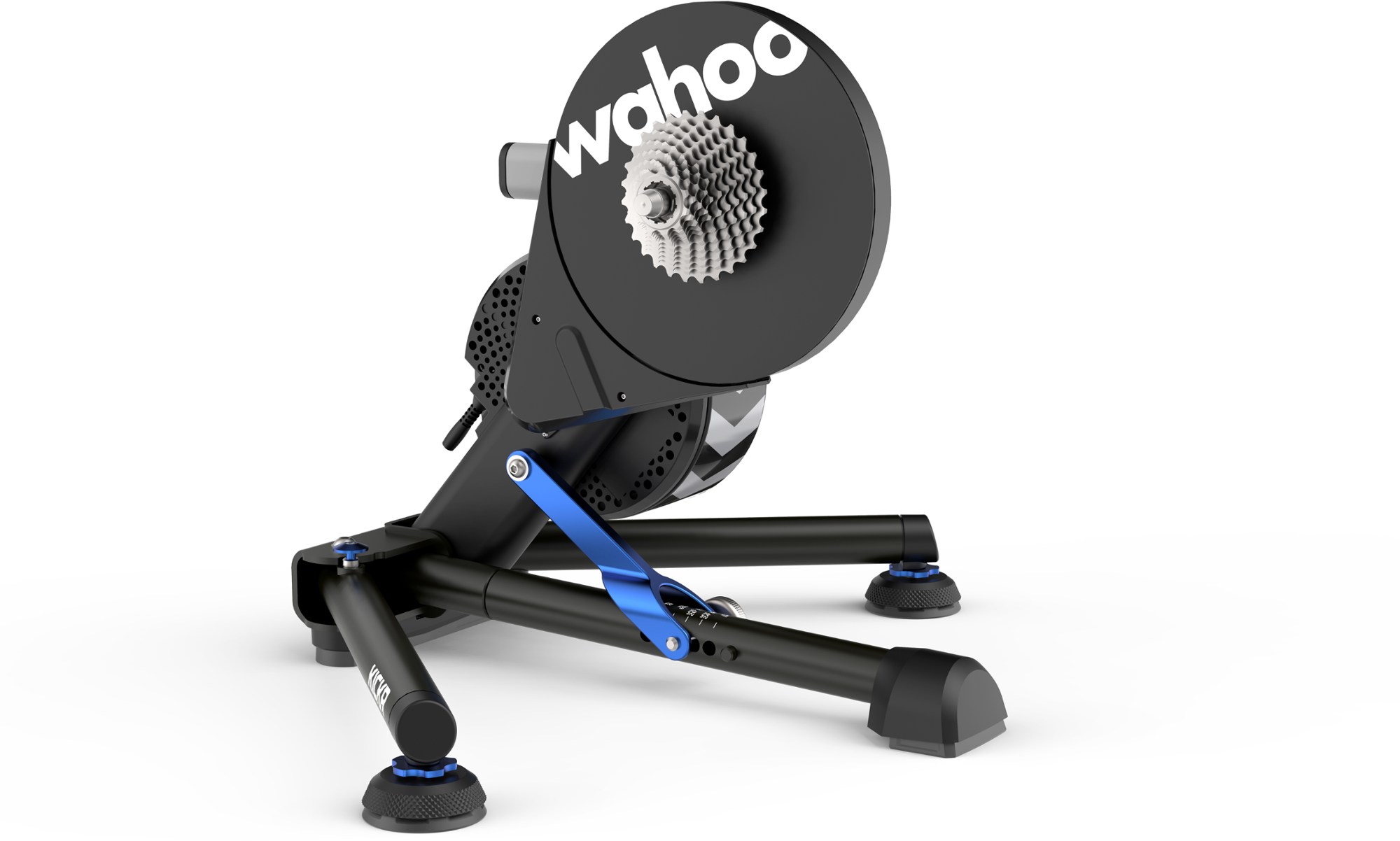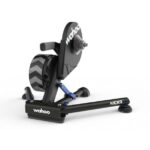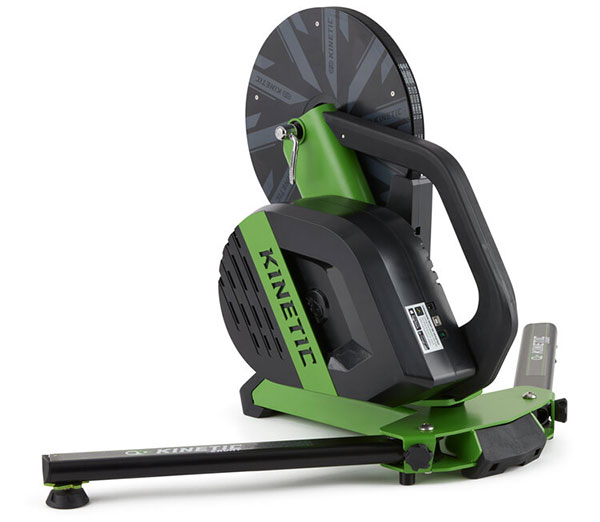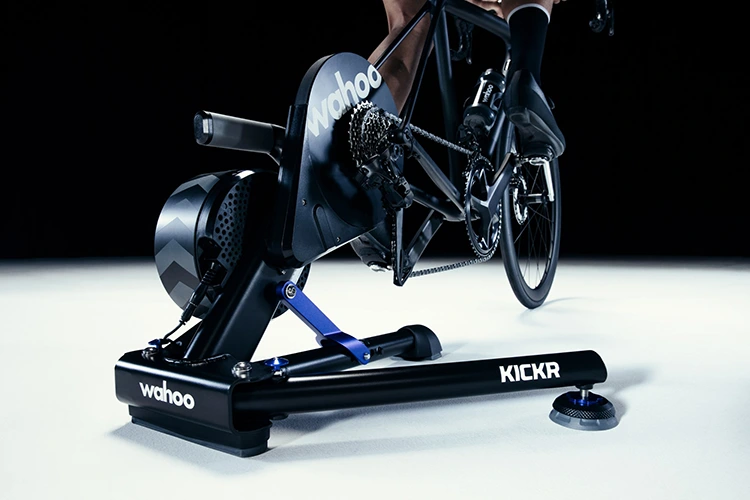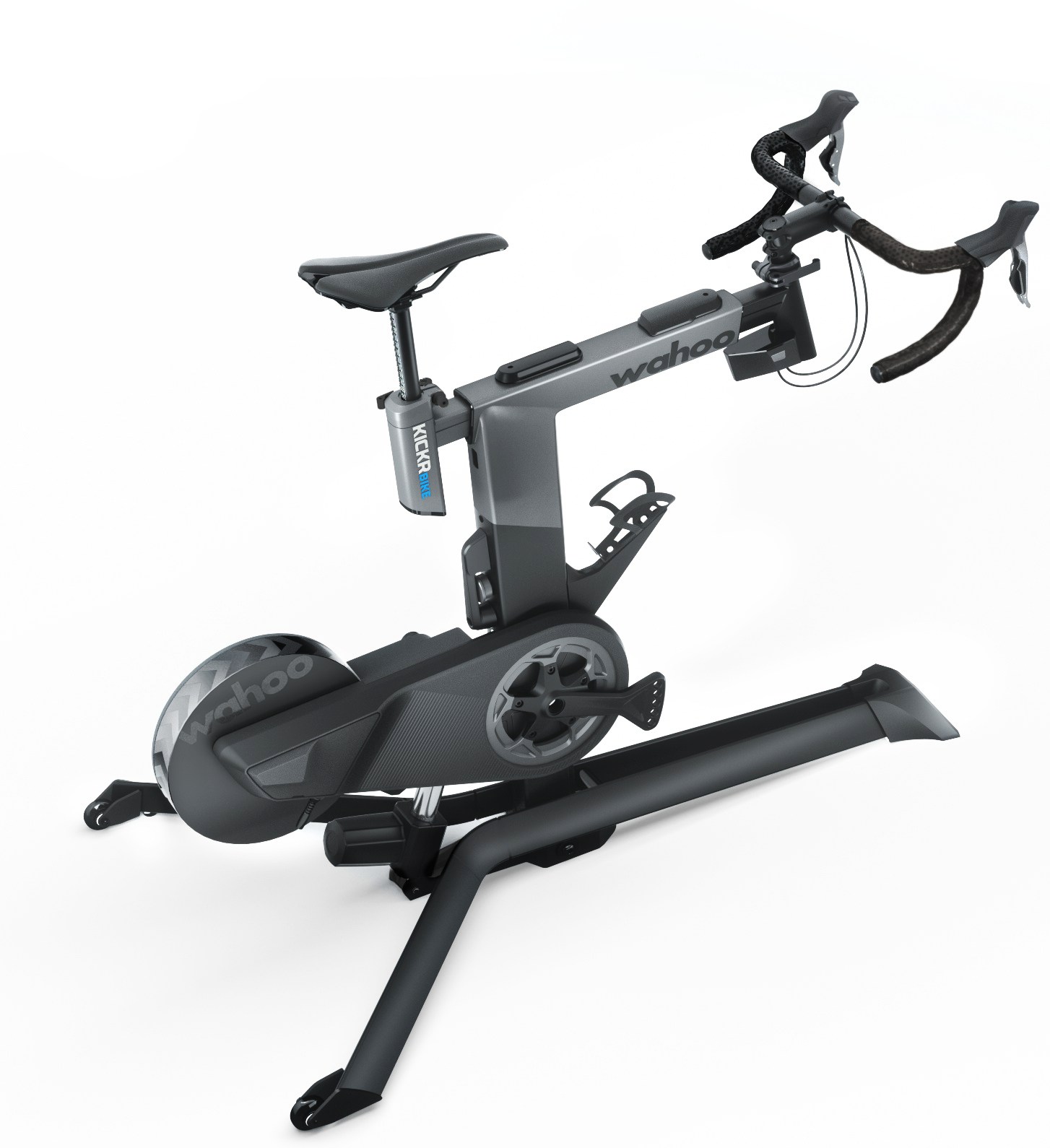With a number of updates and add-ons, the latest generation of the Wahoo KICKR is a beauty.
You’ll never need a more capable trainer, as the KICKR boasts a 2,200w power ceiling and maximum +/-20% simulated gradient.
Don’t let its price tag scare you away, because the Wahoo KICKR is one of the best direct-drive smart trainers on the market.
The trainer is strong, quiet, and offers a great ride feel, putting it at the head of its class.
But let’s take a closer look.
Contents
One of the World’s Most Popular Smart Trainers
The latest version of the Wahoo KICKR comes with a few new features including the KICKR Axis feet and KICKR DIRECT CONNECT Port, as well as class-leading ride feel and power capabilities.
There are few complaints about the KICKR, other than its price tag, and as we dive into the details, it will be easy to see why.
Wahoo KICKR Key Specifications
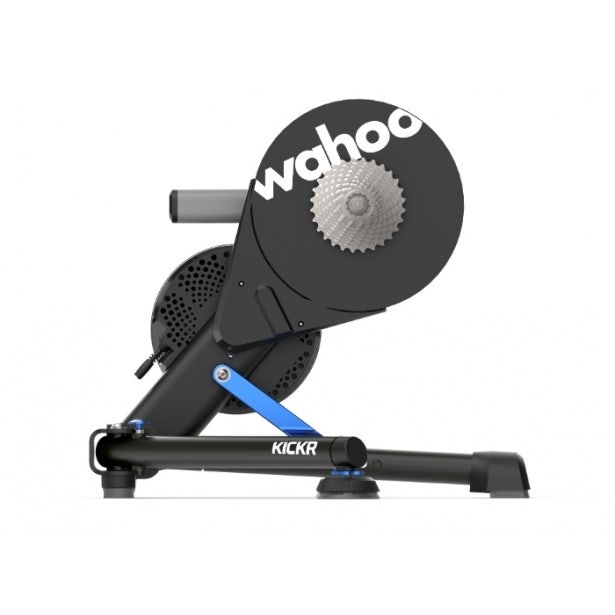
Price: $1,200
Maximum Simulated Gradient: 20%
Power Accuracy: ±1%
Maximum Power: 2,200W at 40kph
Unboxing the Wahoo KICKR is not the easiest process, but it sure does give you a lot of options. One pair of KICKR Axis feet are already attached to the trainer, while two spare Axis feet are included in the box.
Of course, the power adapted is included, along with a power cord. Through axle adapters are included, as well as spacers and a disc brake tool.
The Wahoo KICKR works with 130 and 135 quick release hubs, as well as 142x12mm & 148x12mm thru-axle.
An 11-speed cassette is included – one of the missing features from the Wahoo KICKR Core – while the unit is compatible with 8, 9, 10, and 11-speed cassettes; if that wasn’t enough, the KICKR is compatible with 12-speed cassettes with an XC/XDR adapter.
While a cadence sensor was included in previous versions of the Wahoo KICKR, the latest version does not have one, and that’s because cadence is now broadcast from the trainer, as well as power.
Featuring the same 16lb flywheel as previous generations, the Wahoo KICKR is one of the best when it comes to ride-feel and low noise levels.
Cheaper direct-drive smart trainers have much smaller flywheels, which means they can feel heavy and choppy.
For dedicated indoor riders that spend hundreds of hours on the trainer, the ride feel of the Wahoo KICKR is certainly worth the price.
Related: How To Improve Your Cycling
Even the strongest sprinters will have no problem breaking the KICKR’s 2,200w power ceiling, making the KICKR one of the ultimate indoor training and racing tools.
Setup and Connectivity

Since the Wahoo KICKR is a direct drive smart trainer, you’ll need to remove your rear wheel to set your bike up on the trainer.
Direct drive smart trainers are great because they are quieter and more accurate. They even offer a better ride feel compared to wheel-on smart trainers.
You are also at a greater risk of experiencing wheel slip on a wheel-on trainer, regardless of whether it is smart or not. Besides that, wheel-on trainers can’t get anywhere close to the power accuracy and maximum power ratings of direct drive smart trainers.
Wahoo lays out a quick guide for which KICKR feet to use, the simplest being the rider’s body weight. In addition to that, you can also choose Axis feet based on desired movement, or how much you want the KICKR to move while riding.
You can also buy the Axis feet on their own: the pair of three costs $79, and they are compatible with all the older KICKR versions. Note: they are NOT compatible with the KICKR Core or KICKR Snap.
The Wahoo KICKR wirelessly connects with third-party training apps such as Zwift or TrainerRoad and can simulate gradients up to +20%. With a power accuracy of +/-1% (at least, that’s what Wahoo claims), the KICKR is second-to-none in the world of direct drive smart trainers.
Wahoo has also added a wired connectivity option at the rear of the trainer. It’s called the KICKR DIRECT CONNECT Port – just in case you’d rather skip the wireless process.
You’ll need to buy an adapter to get your KICKR hooked up with your Ethernet. Once it’s set up, you’re good to go.
Wired connectivity helps eliminate dropouts and connectivity issues, which can crop up in highly-wired environments such as a busy apartment building.
Upgrades
The latest version of the Wahoo KICKR – the current model is the fifth generation – has a number of new and updated features.
The trainer comes with three different styles of compression pads that go on the end of its feet, called the KICKR Axis.
These add just a little bit of cushion and movement to better mimic real-world riding. In order to change the Axis feet, you simply unscrew them and swap them out.
For direct drive smart trainers, there is nothing quieter than the Wahoo KICKR. The only thing that you’ll hear is your drivetrain and the sound of your breathing. Even at 50kph, the KICKR is hardly but a faint whir in the background.
Power accuracy has narrowed from +/-2% to +/-1%, putting the V5 KICKR at the top of the smart trainer class.
The updated KICKR also comes with automatic calibration, meaning that no Spindown is required. This was an interesting move from Wahoo because it didn’t really change anything in terms of accuracy and calibration.
On previous models, riders could cheat the calibration on their KICKR and put out inflated power numbers on Zwift.
Now, the KICKR overrides these calibrations and does an auto-calibration itself. So you can try and cheat all you want, but within two minutes, the KICKR will auto-calibrate, and set you back to reality. All this leads to power accuracy, which Wahoo claims is +/-1% in the KICKR.
It’s a tough claim to back up. To say that your trainer is the most accurate on the market – but the KICKR gets close.
Wahoo KICKR Considerations
One of the most common features of top-end direct-drive smart trainers is that they do not work without their power cable being plugged in.
This is because they are purpose-built indoor training machines. They are not meant for convenient travel or pre-race warm-ups.
It’s a major downside for anyone that wants a trainer that can do it all, especially when you consider the KICKR’s price tag.
If you’re willing to spend this much on an indoor smart trainer, chances are that you race and compete. If you’re looking for a trainer for your pre-race warm-up, you’ll need to make another couple hundred dollar investment.
The KICKR Axis feet are a wonderful new feature on the Wahoo KICKR, but do they actually do anything? The price of the KICKR has jumped up in recent years, and the latest version costs $1,200.
The Axis feet are one of the defining add-ons included in the latest model. If you already have a trainer mat or relatively soft surface to set your trainer on, the Axis feet don’t really do much.
Its legs are supposed to offer up to five degrees of flexion. You get just as much – if not more – of not when rocking side to side on a trainer mat. So for an $80 add-on, it’s hard to argue that the Axis feet are worth it.
While the KICKR DIRECT CONNECT Port is another neat new feature, it might not even be worth it. You’ll need to buy an adapter (adding costs) just to get the thing to work.
Even then, the KICKR’s Bluetooth and wireless integration technology is up there with the best. Dropouts are rare, and issues are uncommon. So the extra feature is really just an extra feature that no one uses.
If you don’t want to spend $1,200 or want something that would be more beginner-friendly, then keep reading. Wahoo offers a number of other trainers, including wheel-on trainers, direct-drive smart trainers, and even an indoor smart bike.
Bigger Issues (!)
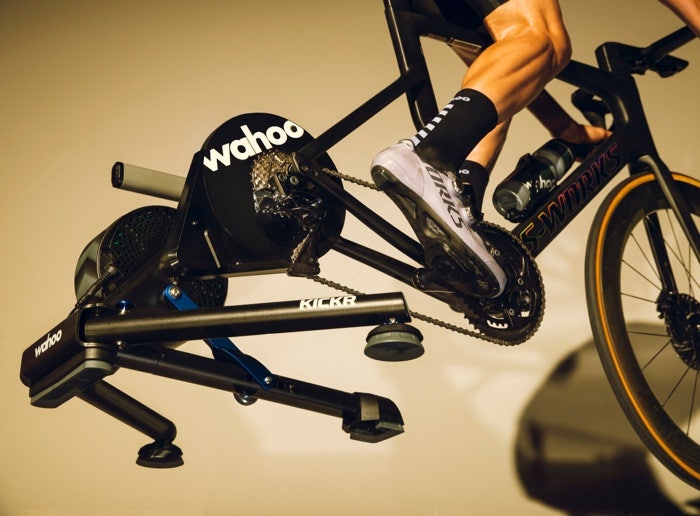
The KICKR is known to overestimate its power reading (during small surges, especially at low cadences). Sometimes by as many as 100w.
I’ve had teammates take advantage of this loophole in Zwift, testing their sprint in an unusually big gear and starting from a low cadence or rpm.
In independent testing, they were able to get their KICKR to read over 1,300w of peak power when they know in reality – and through dual-recorded data from their crank-based power meter – that they did not do more than 1,200w.
Zwift just released an update to their Ruleset in the summer of 2021. Included was a narrowing of the smart trainer requirements, from +/-3% power accuracy to +/-2% power accuracy.
They also require riders to dual record their power data during races. Any rider with a discrepancy of more than +/-5% will get disqualified.
This poses a problem to elite-level Zwifters who compete on Wahoo KICKRs.
Through no fault of their own, they could be over-estimating their sprint power by +100w and getting disqualified simply because their KICKR didn’t read accurately. Wahoo is continuing to work on these problems and release firmware updates.
For a $1,200 trainer known for being one of the best, it’s a worrisome problem.
The last thing that we’ll add to our list is the unexpected and catastrophic failures that have plagued KICKRs past.
Wahoo (understandably) hasn’t released many details about what is happening. Still, thousands of riders from around the world have experienced their Wahoo KICKR completing failing.
All of a sudden, a wrenching noise starts coming from the trainer, and just like that, it stops working. Of course, Wahoo says that this shouldn’t happen with the latest KICKR. For a company and product with a multi-year history of product failures, it’s concerning, to say the least.
With all that said, Wahoo has run a number of firmware updates to improve power accuracy and eliminate wattage spikes, as well as improving its manufacturing process to increase reliability.
So far, the results are promising. The number of customers with broken KICKRs has decreased dramatically in the last two years alone.
Other Wahoo Indoor Trainers
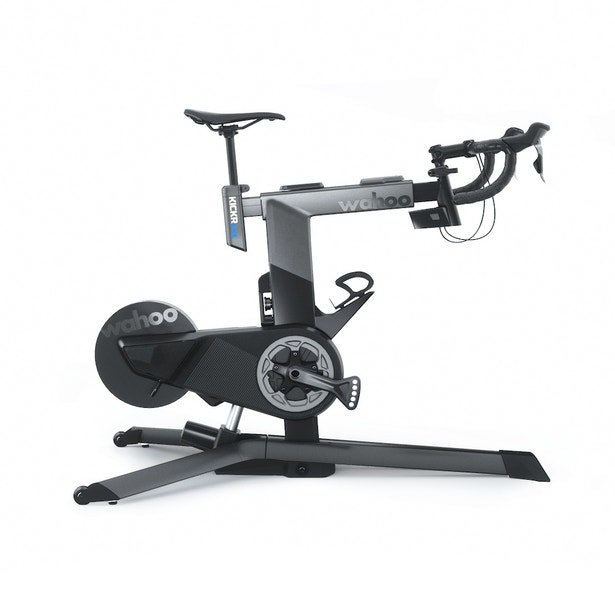
Let’s take a closer look at some of the other indoor trainers from Wahoo:
- Wahoo KICKR Core ($899.99) – coming without a cassette, and lacking just a little bit of overall quality compared to the Wahoo KICKR, the KICKR Core takes a big slash off the KICKR’s price. With an accuracy reading of +/-2%, the KICKR Core is one of the best direct-drive smart trainers at a mid-level price point.
- Wahoo KICKR Snap ($499.99) – the wheel-on smart option from Wahoo, the KICKR Snap is the most accurate wheel-on trainer on the market at +/-3% power accuracy. It costs less than the Wahoo KICKR Climb at just $500, and can generate 1500w of resistance. It’s sleek, portable, and light compared to all direct drive trainers. It’s a great travel tool for indoor cycling adventures.
- Wahoo KICKR Bike ($3,500) – Called the “Ultimate Indoor Training Machine,” by Wahoo, the KICKR Bike is exactly that. There’s no better indoor riding experience than on the KICKR Bike, and that comes at a price. With a KICKR Climb integrated at its front end, the KICKR Bike makes it feel like you’re actually riding around Watopia.
For more direct-drive smart trainers take a look at our reviews of Elite Suito, Saris H3, and Tacx Flux.
Or see the best indoor bike trainers (in our opinion).
Summary
 The KICKR’s 16lb flywheel and impressive power capabilities make it one of the leading options for direct drive smart trainers.
The KICKR’s 16lb flywheel and impressive power capabilities make it one of the leading options for direct drive smart trainers.
Few can match the gradient and accuracy measurements of the KICKR, especially at the $1,200 price point. The only way to go up is to make the leap to a dedicated indoor smart bike, such as the Wahoo KICKR Bike.
As we’ve seen the KICKR Bike is an impressive feat of engineering that will give you the ultimate indoor riding experience, but it comes at a steep cost.
In fact, you could almost buy three Wahoo KICKRs for the price of one Wahoo KICKR Bike.
The biggest downsides of the Wahoo KICKR are its power spikes and reliability issues. Since its release in 2020, most of these issues seem to have subsided.
Of course, they will never completely go away, but Wahoo has done a fantastic job updating their KICKRs. They’ve improved power accuracy and reliability and have created a product that customers can count on.
Other than that, there’s not much to complain about. If you’re in the market for a top-of-the-line direct-drive smart trainer, there’s hardly a better option than the Wahoo KICKR.

